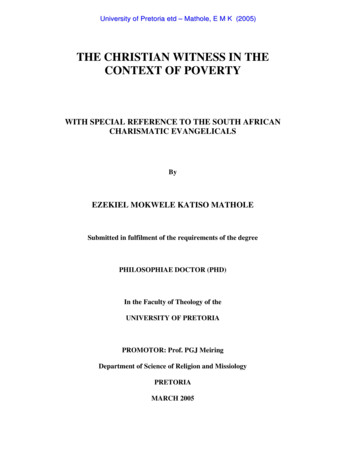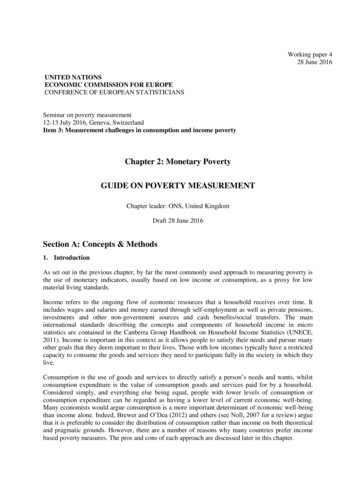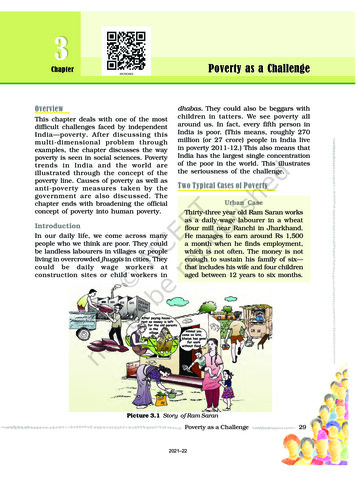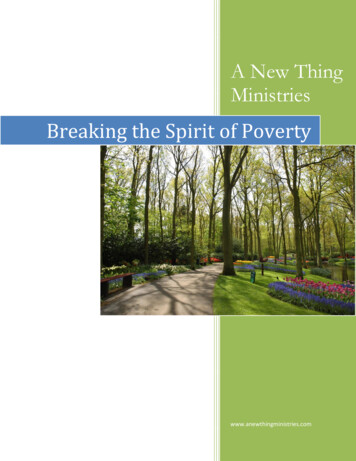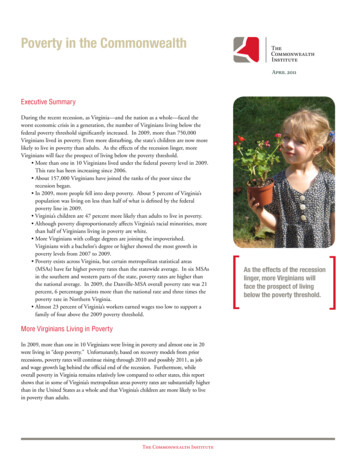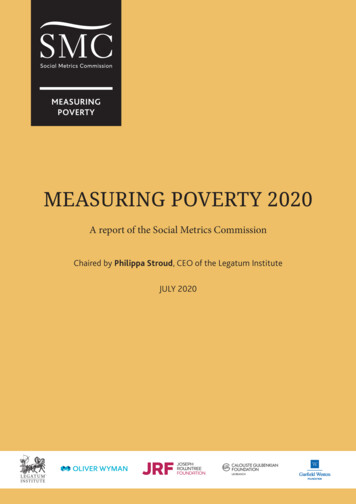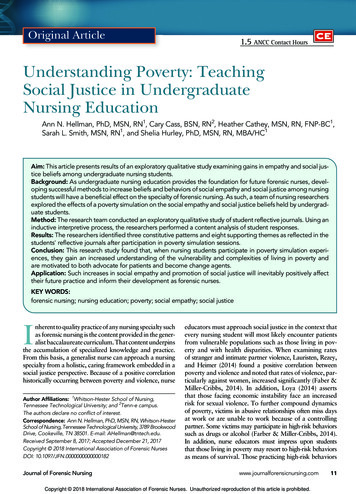
Transcription
Original Article1.5 ANCC Contact HoursUnderstanding Poverty: TeachingSocial Justice in UndergraduateNursing EducationAnn N. Hellman, PhD, MSN, RN1, Cary Cass, BSN, RN2, Heather Cathey, MSN, RN, FNP-BC1,Sarah L. Smith, MSN, RN1, and Shelia Hurley, PhD, MSN, RN, MBA/HC1Aim: This article presents results of an exploratory qualitative study examining gains in empathy and social justice beliefs among undergraduate nursing students.Background: As undergraduate nursing education provides the foundation for future forensic nurses, developing successful methods to increase beliefs and behaviors of social empathy and social justice among nursingstudents will have a beneficial effect on the specialty of forensic nursing. As such, a team of nursing researchersexplored the effects of a poverty simulation on the social empathy and social justice beliefs held by undergraduate students.Method: The research team conducted an exploratory qualitative study of student reflective journals. Using aninductive interpretive process, the researchers performed a content analysis of student responses.Results: The researchers identified three constitutive patterns and eight supporting themes as reflected in thestudents' reflective journals after participation in poverty simulation sessions.Conclusion: This research study found that, when nursing students participate in poverty simulation experiences, they gain an increased understanding of the vulnerability and complexities of living in poverty andare motivated to both advocate for patients and become change agents.Application: Such increases in social empathy and promotion of social justice will inevitably positively affecttheir future practice and inform their development as forensic nurses.KEY WORDS:forensic nursing; nursing education; poverty; social empathy; social justicenherent to quality practice of any nursing specialty suchas forensic nursing is the content provided in the generalist baccalaureate curriculum. That content underpinsthe accumulation of specialized knowledge and practice.From this basis, a generalist nurse can approach a nursingspecialty from a holistic, caring framework embedded in asocial justice perspective. Because of a positive correlationhistorically occurring between poverty and violence, nurseIAuthor Affiliations: 1Whitson-Hester School of Nursing,Tennessee Technological University; and 2Tenn-e campus.The authors declare no conflict of interest.Correspondence: Ann N. Hellman, PhD, MSN, RN, Whitson-HesterSchool of Nursing, Tennessee Technological University, 3789 BrookwoodDrive, Cookeville, TN 38501. E-mail: AHellman@tntech.edu.Received September 8, 2017; Accepted December 21, 2017Copyright 2018 International Association of Forensic NursesDOI: 10.1097/JFN.0000000000000182Journal of Forensic Nursingeducators must approach social justice in the context thatevery nursing student will most likely encounter patientsfrom vulnerable populations such as those living in poverty and with health disparities. When examining ratesof stranger and intimate partner violence, Lauristen, Rezey,and Heimer (2014) found a positive correlation betweenpoverty and violence and noted that rates of violence, particularly against women, increased significantly (Faber &Miller-Cribbs, 2014). In addition, Loya (2014) assertsthat those facing economic instability face an increasedrisk for sexual violence. To further compound dynamicsof poverty, victims in abusive relationships often miss daysat work or are unable to work because of a controllingpartner. Some victims may participate in high-risk behaviorssuch as drugs or alcohol (Farber & Miller-Cribbs, 2014).In addition, nurse educators must impress upon studentsthat those living in poverty may resort to high-risk behaviorsas means of survival. Those practicing high-risk behaviorswww.journalforensicnursing.comCopyright 2018 International Association of Forensic Nurses. Unauthorized reproduction of this article is prohibited.11
Original Articleand trapped in impoverished situations pose a higher probability of being eventually cared for by a forensic nurse inthe contexts of intimate partner violence, sexual violence,intentional injury, and neglect. Presenting such populationsto students effectively, nurse educators must present information in the context of social justice.Social justice is an idea many professions and especiallythose related to health care identify as necessary to incorporate into practice. It is suggested by Windsor, Shorkey, andBattler (2015) that “social justice requires a society whereresources are equitably distributed and the full potential of allof its members is supported” (pp. 60–61). Drevdahl (2013),however, argues that social justice has not been adequatelydefined but proposes an understanding of “justice as havingto do with fairness, especially with respect to how people aretreated, how decisions are made, and how resources aredistributed, all of which apply to health and health care”(p. 49). Nevertheless, one is cautioned to examine the meaning further by Edmonson, McCarthy, Trent-Adams, McCain,and Marshall (2017) stating that “social justice is more thantreating people fairly; it involves rejection of the status quofor the greater good” (para. 17). Although the definitionmay be debatable, many agree that social justice is a worthypursuit requiring the involvement of many healthcare areas.Dilworth-Anderson, Pierre, and Hilliard (2012) discuss howthe application of social justice for healthcare is not exclusiveto one area of healthcare but rather all areas. They further addthat, “in the context of health disparities, social justice refersto the minimization of social and economic conditions thatadversely affect the health of individuals and communities”(Dilworth-Anderson et al., 2012, pp. 26–27). Finally, theAmerican Nurses Association emphasizes the importance ofsocial justice in their ethics and human rights statementasserting that “ethics, human rights, and nursing convergeas a formidable instrument for social justice and humanrights must be diligently protected and promoted” (Butts& Rich, 2016, Appendix B, p. 483).There is limited research examining the incorporationof social justice into undergraduate nursing education, yetsocial justice is central to leadership within the nursingprofession (Groh, Stallwood, & Daniels, 2011). TheAmerican Association of Colleges of Nursing sets forththe Essentials for Baccalaureate Education as the guidefor building the framework and curricular elements forbaccalaureate nursing education in the 21st century. Theteaching of social justice is identified as one of the essentials of baccalaureate nursing education (Groh et al.,2011). Among the assumptions put forth by the Essentialsdocument is that student nurses will be educated in a waythat promotes practice from a holistic, caring frameworkas they provide direct and indirect care for diverse populations. Weaving social justice into baccalaureate nursingeducation in contexts of vulnerable populations andhealth disparities is vital to our society and our patients.12www.journalforensicnursing.comAn integral part of understanding and promoting socialjustice as nurses is the development of social empathy. Asdefined by Segal (2011), “social empathy is the ability to moredeeply understand people by perceiving or experiencingtheir life situations and as a result gain insight into structuralinequalities and disparities” (p. 266). Segal and Wagaman(2017) found that social empathy developed student' understanding of social justice. Nurse educators strive to findmethods by which to assist the students' development ofsocial empathy. Simulations are proving to be gatewaysto an increased understanding of patient experiences.Since the 1940s, nursing education has promoted increased use of simulations as excellent teaching tools because students become stakeholders in the process oflearning (Sanford, 2010). Using contextually based simulations to explore conditions that create opportunitiesand inequalities, students learn in three ways: throughexposure, by which students learn of the differences andinequalities that structure people's lives; through explanation, which promotes the students to gain insight of howand why lives are structured because of differences and inequalities; and through experience, by which studentsimagine themselves in the lives of people whom they consider to be different from themselves (Adelman, Rosenberg,& Hobart, 2016). Poverty simulations provide contextually based learning environments by which students cangain knowledge in these three ways. Nickols and Nielsen(2011) concluded after their experience with poverty simulation that simulation was an adjunct to the classroom and“develops a more nuanced understanding of what it meansto be poor [where] surely, this understanding is a precursor, if not a companion, of social empathy” (p. 40).Therefore, nurse educators might consider the use of poverty simulations to build social empathy and assist studentsin understanding social justice.The purpose of a poverty simulation is to encouragestudents to reflect on the misconceptions, biases, and judgments regarding people who live in poverty and experience some of the pressures that they face within a safeenvironment. Segal (2011) asserts that the best way tochange inequalities and disparities is to create experiencesin which people can gain “deep contextual knowledge andhave experiences that create empathetic insights into thelives of people who are oppressed” (p. 267). Without developing social empathy, people may be prone to believingstereotypes and be intolerant of others who are different.In contrast, Segal proposes that developing social empathyleads to positive behaviors and interactions such as cooperation, altruism, helping others, deepened understanding ofothers' needs, belief in social responsibility, and consideration of needed social changes. Segal further asserts that“individual empathy alone is insufficient to lead us to solutions for large-scale domestic or global problems. Therefore, if the understanding of large-scale social problemsVolume 14 Number 1 January-March 2018Copyright 2018 International Association of Forensic Nurses. Unauthorized reproduction of this article is prohibited.
Original Articlelike poverty is limited to individual perception, it can beflawed or inaccurate” (p. 270). Design/MethodsTo identify changes in attitudes and understanding of livingin poverty in senior baccalaureate students, a team of nursing researchers conducted an exploratory qualitative studyusing content analysis to investigate the possible increase inempathy and social justice beliefs among undergraduatenursing students. The researchers situatedthe study in a stateuniversity baccalaureate nursing program's communityhealth course for senior level nursing students. Study participants numbered 113 and were between the ages of 22 and47 years, were predominantly female (male 14, female 99), largely White (White 110, Black 2, Pacific Islander 1), and lived in primarily a rural area before entering the university (rural 79, urban 34). As one of the final courses oftheir education, the “healthcare of communities” course isperfectly situated to immerse students into practices promoting an appreciation of living in poverty and a greater understanding of social justice. In addition, most of these graduateswill practice within a state having poverty rates above thenational average with one of every six residents living inpoverty (18.4%; Times Free Press, 2014). It is imperativefor them to gain in-depth understanding as it will significantly influence their nursing practice. As a generalist curriculum is a requirement of nurses who may specialize inforensic nursing, it is essential that educational methodsfostering the development of increased empathy and practice of social justice behaviors be incorporated.The poverty simulation kit was developed by the MissouriAssociation for Community Action. After university institutional review board approval, individual reflection journalsfrom three different intervals of the two-part poverty simulation activity provided data for analysis. The povertysimulation occurred on 2 different days with at least1 week in between sessions to promote student reflectionon the experience. Before the first simulation experience,students were asked the following questions to examinetheir understanding of and initial feelings toward thosewho live in poverty. The reflection journal questions usedwere as follows: “Describe what you think ‘living in poverty’ means,” “What would that experience be like?”,“Why do you think people live in poverty?”, “Why doyou think the unemployed/underemployed can't find ajob?”, “Under what circumstances should the governmenthelp people?”, “How do you feel when you see people living on the street?”, and “Do you think that people whoare living in poverty are to blame for their situation?” Aftercompleting the first poverty simulation session and beforeentering into the second session, students were asked to describe their feelings about participating in the simulation asecond time using the following question: “As you thinkJournal of Forensic Nursingabout entering the poverty simulation for the second time,please describe your feelings.” After completion of thesecond simulation session, students answered questionsabout their experience, were encouraged to explore howtheir feelings may have changed because of the two simulation sessions, and were prompted to share how theywould use this experience to guide their future nursingpractice. The questions used were as follows: “How willyour experience in the poverty simulation affect your future nursing practice?”; “If you were given the opportunity to describe the effects of living in poverty on yourdecision making to your colleagues, what would you say?”;and “How have your feelings about poverty and living inpoverty changed as a result of participating in the povertysimulation?” Inductive content analysis of the students' reflection journals by the research team occurred at the conclusion of all simulation sessions. Central themes andstudent exemplars are presented in the following section. FindingsReading, analyzing, and inductive interpretive process produced three constitutive patterns and eight supportingthemes. The constitutive patterns were “exploring self andprevious beliefs,” “enhanced understanding,” and “recognizing need for action.” Data revealed that students performed a process of self-reflection about previously heldopinions of the impoverished population.Exploring Self and Previous BeliefsStudents' responses lead to the constitutive pattern of “exploring self and previous beliefs.” Supporting themes of thispattern included “feeling unsafe,” “blaming the poor,” and“doing anything to survive.” The concept that theimpoverished and homeless live in unsafe environments ledmany students to report feelings of danger and need forcaution when exposed to this population.I am cautious when I see homeless people. Iquestion their intent.It is easy to feel fearful due to the stigma surrounding homeless people. Homeless people canoften be dangerous.Sometimes these people also frighten me because I am scared they may try and steal from me.Sometimes I am even fearful of those living onthe street because there are situations where theycan be quite aggressive.Data included information about who students feltwere to blame for this population's situation and whenwww.journalforensicnursing.comCopyright 2018 International Association of Forensic Nurses. Unauthorized reproduction of this article is prohibited.13
Original Articlegovernment assistance was appropriate. Many felt thatpoor decision-making (ie, criminal activity, drug and alcohol abuse, poor financial planning) and lack of initiativeor drive were largely to blame. Students also voiced thatgovernment assistance should be withheld from those ofthis population who participate in illegal activities, withdrug screening being a qualifying caveat. This resulted inthe supporting theme “blaming the poor.”I do not believe that people who abuse the system should be helped anymore; examples includedrug abuse, selling food stamps and fraud.I do not support government assistance forpeople with long arrest records and those whocannot pass drug tests.You can also have those people who are justtoo lazy to get jobs or buy drugs and partake inillegal activities which prevents them from gettingjobs, and I feel these types of people are to blamefor their poverty.I believe that some of the people living on thestreets are “to blame” because of the choices thatthey made whether it be drugs or gang association.Presimulation responses targeted participants' preconceptions regarding the impoverished population. Beforeparticipating in the simulation, students reported a negativefeeling toward the impoverished and high rates of criminalactivity among this population. Between the first and secondsimulation sessions, students expressed a better understanding as to why this vulnerable population is often associatedwith criminal activity and an unsafe environment. Illegal activity began to be viewed as a means of getting by and a wayof survival, leading to the theme “doing anything to survive.”They reported finding themselves considering or engaging inillegal acts during the simulation as a means of survival.With these situations, many times, people areforced to participate in illegal activity (drug dealing,prostitution, etc.) simply to make ends meet andprovide that bare minimum for their families.There came a point in time during the simulation where all of our resources had been exhaustedand my mind immediately thought about doing illegal activities just to provide for my family.You almost stop caring about the consequencesof the situation. You don't care if you have to stealmoney to feed your child, because if you do notfeed your family they could possibly die.14www.journalforensicnursing.comThese people are often so desperate that theywill turn to illegal activities to make money andthis is often out of necessity, not because theyhave poor moral character.It was stressful and overwhelming. This leadsto poor decision making because you eventuallyget to a point where you simply have to do whatever you can to survive. Whether it may be something unethical or illegal.Enhanced UnderstandingSupporting the constitutive pattern of “enhanced understanding,” themes of “living stressfully” and “affectingone's health” emerged from the data. Students reflected onthe emotions that would surround living an impoverishedlife. Feelings of fear, high stress, hopelessness, and frustration repeatedly appeared in the students' reflection entriesaswell as a general changein perspective regarding membersof this population. Reflecting on the experiences and emotions that someone in poverty might feel resulted in expressions of empathy, compassion, and sadness by the students.For some, the simulation increased previously held feelings;for others, such feelings emerged from exposure to an unknown or unnoticed way of life. Students particularly referenced the population's ability to access health care.The experience (poverty) would be scary, stressful, and a daily struggle.It can truly happen to anyone. You do not haveto be lazy or a drug addict to be living in poverty.It has changed my way of thinking because previously, I figured that people who lived in povertyput themselves in that situation.It's no wonder this population is so vulnerableto disease and health concerns. Aside from notbeing able to afford and often receive health carebecause of logistical concerns, the amount ofstress these people deal with is enough for anyoneto have a mental breakdown, every day.Ultimately poverty causes individuals to makedecisions that might make a negative impact onhealth and wellness but if they don't make thosechoices them or their children might not eat orhave a place to live.My health came last to my child's and otherfamily members. I imagine this is the same in trueimpoverished family situations.Volume 14 Number 1 January-March 2018Copyright 2018 International Association of Forensic Nurses. Unauthorized reproduction of this article is prohibited.
Original ArticleAfter the completed simulation sessions, researchersprompted students to explorehow the constraints of povertyimpacted their decision-making and how the experiencemight influence their future nursing practice. Many reportedthat the overwhelming stress of poverty ultimately led topoor decision-making during the simulation. They also reported gaining a greater understanding of why this population resorts to criminal activity and acknowledged themisconceptions surrounding noncompliance versus inability to comply within this population.Recognizing Need for ActionIn addition, a recognition of a desire to change currentnursing care for persons experiencing impoverishmentwas evident. Composing the constitutive pattern of “recognizing the need for action” are the supporting themesof “listening actively and compassionately,” “calling foradvocacy,” and “promoting equity.” The constitutive pattern of “recognizing the need for action” is most evident inthe prevalence of students voicing a desire for action toproblem-solve for impoverished patients. This was expressedin terms of being engaged listeners, being active observers,and being involved participants with their patients. Torecognize when intervention is needed, “listening activelyand compassionately” should be a nurse's first responseas manifested in the following exemplars.It makes you want to work with them moreand really connect with them so you know theyaren't going home worried about what is goingto happen next.I think this will also help me to work with my patient struggling with this issue to be able to handlelife decisions and issues if I understand their stress.I feel this simulation will help me remember during times of stress and/or when patients are askingfor multiple items you never know what they aregoing through at home and to show compassionfor them because you never know one's situation.I think seeing it from a family's perspective helpsme better understand how to be compassionate andlook differently at situations and hopefully when Ido get the opportunity to care for a homeless orthe very low income population, that I can be betterof assistance and help to make changes to their lives.The supporting theme of “calling for advocacy” was evident throughout students' reflections. Advocacy was linkedto an increased desire for action after a better understandingof impoverished people, an expressed goal of decreasingthe struggle or stress of those in poverty, an emphasis onJournal of Forensic Nursingself-awareness for better treatment of these patients, andrealization that nurses have active roles in advocacy inall facets of patient care. After experiencing restraints inherent in poverty, students emphasized the need to avoidcomplacency in providing care.As a nurse, my goal is to be an advocate forthese patients who may not understand the medical system process or what they are able to receive and I hope to be their voice.I never judged someone based on their financialstatus before simulations . This simulation hasopened my eyes that I need to go above and beyondto advocate for my patient more that I already do.I will also remember to keep this simulation inmind when advocating for patients by avoidingunnecessary charges and making sure they canafford the medications that are prescribed.We must refer them to the right people in orderfor them to obtain needed resources in order forsurvival. It's our job to be patient advocates andassure our patients can maintain health statusoutside of the hospital.Finally, self-awareness of prejudice and need for equaltreatment were observed in the theme of “calling for advocacy.” A prompter question in a reflection journal guidedstudents to consider how they would approach teachingtheir colleagues about poverty. This question encouragedstudents to connect the current poverty simulation to theirfuture nursing environment.I would tell my colleagues poverty isn't whatyou think it is . Next time you have a patientwho is living in poverty or homeless, considerhis/her story and be an advocate not a gossip inthe nurse's station.I would say [to future nursing colleagues] tohave patience and treat all patients the same. Eventhough it may be easy to judge, we never knowwhat someone has been through.We, as nurses, must remain non-judgmentaland treat the patient the best we possibly can,no matter what our views or opinions may be.I would advise them to not be so quick to basha patient about not having insurance or attendinga cardiac rehab session. Sometimes patients haveto pick between going to cardiac rehab and eating.www.journalforensicnursing.comCopyright 2018 International Association of Forensic Nurses. Unauthorized reproduction of this article is prohibited.15
Original ArticleForgive them if they are not the “best” patient,because they are just worried about how they willbe able to make it.The final supporting theme of the constitutive pattern“recognizing need for action” is the supporting theme of“promoting equity.” Health inequity presented in terms ofpoor perception and stereotypes by health providers. Responsibilities highlighted by students included educatingand connecting patients with health resources, reflectingon patients' situations before judging, increasing selfawareness of prejudice, and probing beyond the surface toassess needs. Education was a large component to responsesabout the nursing role. There was evidence of understandingthat education needs to be appropriate and meaningful aswell as having an emphasis on long-term health and access.For a nurse, it is crucial for us to educate thesepatients that there are support groups, educationon finances, benefits, and other great tools and resources that could really benefit them and savethem a lot of stress and worry.Sometimes people's needs get overlooked dueto different circumstances but as nurses, and asa nurse who has experienced a poverty simulation, it is very important that we do everythingwithin our power to help them receive the aidthey need.Since I know that some people are struggling,but don't want to ask for help, I will make an effort to talk to my patients and find out about theirhome life situation. DiscussionThe intent of a poverty simulation in nursing education is toprepare students for best practice after graduation. Often, insimulations, learning may be mechanical, focusing on tasks;however, on occasion, learning may be profound. Nevertheless, even when learning begins at the mechanical level, understanding may evolve into the profundity the nursingprofession is attempting to cultivate through practice. Asshown in this study, after completion of the first simulationsession, a change in perspectives among students becameevident. Students verbalized that poverty is a complex situation and the causative reasons for such are multifaceted. Inaddition, students expressed that overcoming poverty is adifficult task and living this way is most often not by choice.Although understanding perceptions and stereotypes candecrease equity, students came to better understand that lackof resources (i.e., money and time) decreased equity as well.16www.journalforensicnursing.comStudents' changing perspectives especially focused on howthe impoverished population accesses and uses health care.Student beliefs evolved to increased sympathy and compassion, which challenged their previously held beliefs. Furthermore, such newly discovered understanding fostered a cryfor advocacy on behalf of their patients. In addition, theoverarching idea presented that, through better and informed care, there can and should be a decrease in the struggle and stress of poverty. Use of the poverty simulation in thisstudy supported findings in nursing and other disciplines(Nickols & Nielsen, 2011; Patterson & Hulton, 2011).Vandsburger, Duncan-Daston, Akerson, and Dillon (2010)reportedthat “ it is encouraging to presume that if studentsare exposed to the experience of being poor and they incorporate such experiences, they are more prepared to engagein working with the poor upon graduation” (p. 312). Implications for Clinical ForensicNursing PracticeSimulations to teach technical skills, procedures, and othernuances of forensic nursing practice are common. However, methods to impart beliefs and ethics that contributeto ethical forensic nursing practice are rare (Doane, Pauly,Brown, & McPherson, 2004). Social justice and social empathy as emphasized in the studied poverty simulation provide much needed prominence on the ethical developmentof new nurses. New nurses compose the recruitment basefor the future of forensic nursing practice. As such, encouraging heightened levels of compassion and empathy forvulnerable populations whom they will serve will onlyimprove the quality of care provided. Further provenmethods that increase compassion and empathy towardvulnerable populations might also lead students to chooseforensic nursing over other nursing specialties. Such increases in social empathy and promotion of social justicewill inevitably affect their future practice and inform theirdevelopment as forensic nurses. ConclusionParticipating in a poverty experience can be utilized for thosebecoming nurses to promote awareness, provide a greaterunderstanding of this population, and motivate change.Such is also true for those specializing in forensic nursing.Understanding poverty will allow the nurse to recognizeand respond to the root of health problems and to advocatefor social justice strategies and policies that promote population health (DeChesney & Anderson, 2016). As advocacyis a learned behavior that must start with un
American Association of Colleges of Nursing sets forth the Essentials for Baccalaureate Education as the guide for building the framework and curricular elements for baccalaureate nursing education in the 21st century. The teaching of social justice is identified as one of the es-sentials of baccalaureate nursing education (Groh et al.,
